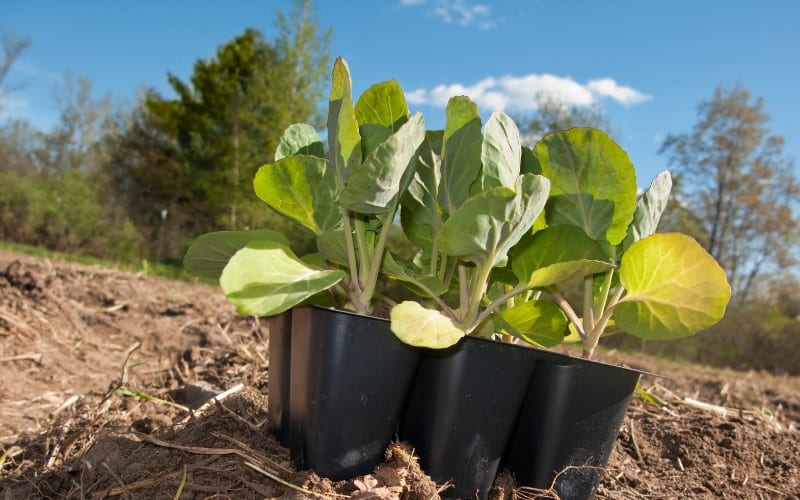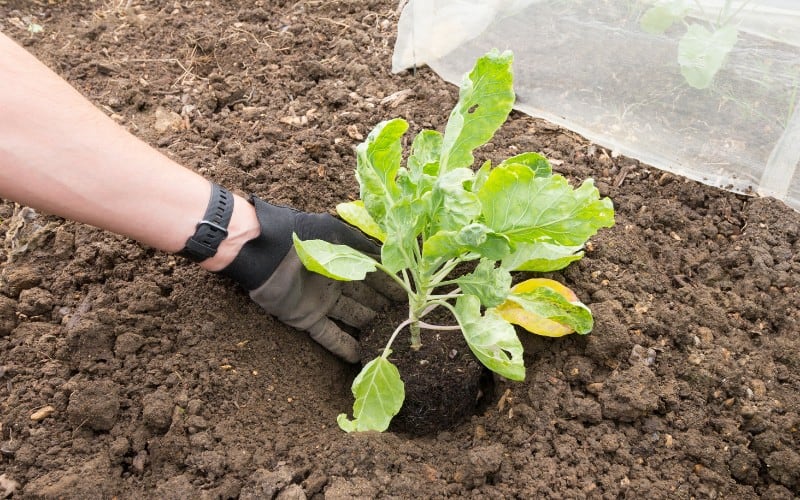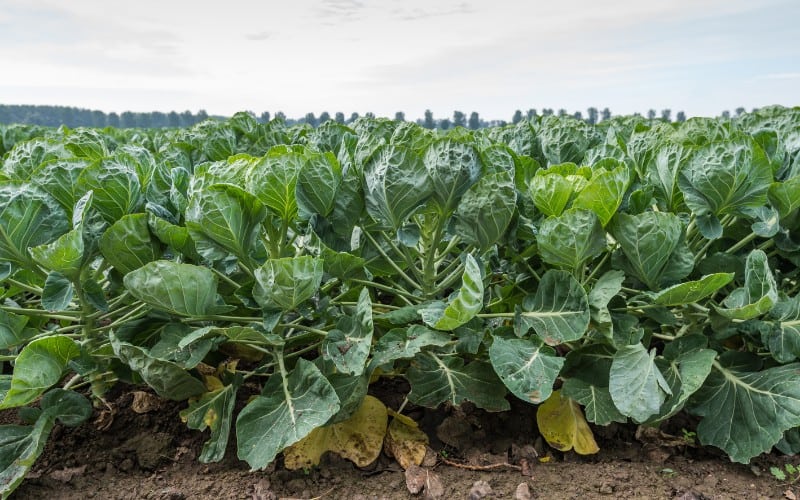Brussel sprouts are members of the cabbage family. Gardeners plant them for their edible buds. They are leafy vegetables, and they resemble small cabbages. The vegetable originated from Brussels in Belgium and got the name 'Brussels' there.
The Brussel sprouts come in many colors. There are purple colors, and there are red colors. The Brussel sprout has a distinct bitter taste. In 1940, a Botanist from the Netherlands cross-bred some varieties of Brussel sprouts to reduce the bitterness.
In previous years, particularly in the US, many people disliked this plant because of the taste. But now it has made a resurgence in US kitchens. In this article, we will look at how to grow Brussel sprouts.
Let's get started!
Read Also: How Tall Can Brussels Sprouts Grow?
Table of Contents
How to Grow Brussel Sprouts | Preparing the Soil for the Planting Of Brussels Sprouts
One of the things to put into consideration while thinking of how to grow brussels sprout plant is the soil where you will plant them. The Brussel sprouts eat heavily. This means you need a ground full of nutrients for a bumper harvest.
You have to add fertilizer to the soil, and gardeners should add the fertilizer within six inches of the earth. Fertilizers are rich in nutrients and are an excellent addition to your plants.
If you intend to plant the Brussel sprouts with pots, you have to do so with an aged compost soil rich with nutrients. The Brussel sprout needs to get all the nutrients they can as soon as you plant them.
The Brussel sprouts are also best planted in alkaline or neutral and firm soil, and to achieve this, you have to prepare the bed properly a few months before planting.
Dig plenty and dig over rich compost and let the soil settle and get ready for planting. The soil also should not be flooded; it should have good drainage.
Thirty days before you plant your Brussel sprouts, test the soil to know its pH. The pH of the soil has to have a pH of at least 7. If you find that it is less than six, you have to add a little lime.
The next thing to do when considering growing Brussel sprouts is preparing the bed for planting. Add compost and make the bed firm. Ensure that the seedbed is moist. Not too wet and not too dry.
How to Grow Brussel Sprouts In Pots
Most gardeners battle with space and that is why knowing how to grow Brussel sprouts in pots is important. Here are tips on growing Brussel sprout plant in pots:
- Get a pot with a depth of 12 inches and a diameter of 12 inches. Get a slow-releasing fertilizer, preferably 14-14-14, take one and a half spoons, and mix with your potting mix. Pour water into the pot until the soil is saturated, and extra moisture starts draining out of the pot's bottom.
- Plant just one seedling of Brussel sprouts in the soil. Make sure you place it as deep as it was when it was in another container.
- Keep the pot where it can get access to bright sunlight all day long. Let the plant start getting the sunlight after planting.
- Touch the soil with your hands every day. Add more water whenever the first inch of the soil has become dry. You need to know that soil in the pot dries out quicker than the soil in the garden or ground. During hot weather, you should water the Brussel sprouts every day.
- Get a 15-30-15 fertilizer and dissolve just one spoon in three liters of water. Add the solution to the Brussel sprouts once every fourteen days. It would be best if you started watering the Brussel sprouts after six weeks of planting.
- When considering how to grow Brussel sprouts, know that the Brussel sprouts need to be constant watering during hot weather, and this will leach nutrients out of the soil. What this means is that you have to reapply fertilizer periodically so your plant does not lack nutrients.
- Always spay attention to the plant to know when the leaves start showing up. Once they do, remove the last 6 to 8 leaves growing on the stalk of the plant. Removal of the leaves will make the plant channel every energy into the development of sprouts.
- As soon as the sprouts form and reach half the mature sprout size, cut the stalk's head, close to the tip, below the stalk's growing point.
- When the Brussel sprouts mature, turn the sprouts off from the stalk. You know mature Brussel sprouts when its diameter has reached one or two inches.
- Start harvesting the sprouts from the stalk's bottom and higher as each sprout mature-sprouts in the lower part of the stem mature first before the ones above them.
Knowing how to grow Brussel sprouts in containers is also advantageous for people who want the Brussel sprouts in a small number.
Tools Needed to Plant Brussel Sprouts in A Pot
You need a few tools when considering how to grow Brussel sprouts in a pot. Here are what you need:
- Shears for cutting off the leaves and sprouts.
- A pot or container that has a depth and diameter of 12 inches.
- Soil suitable for poting. The soil has to be a rich compost soil that was prepared for planting before time.
- 15-30-15 fertilizer that is soluble in water.
- 14-14-14 slow-releasing fertilizer.
What to Keep in Mind
- Potted plants have a lower risk of being pet infested. There is also a lower risk of infection of the plant by diseases.
- Even though this is the case, it is vital to wash your tools and hands before handling the plants. This is to make sure that pests elsewhere do not infest the plant.
- The most typical pest that comes after Brussel sprouts is the aphids. When you use them on your plants, you do not need to use a pesticide. Use a water spray to wash them off the plant.
When to Plant Brussel Sprouts Zone 5
Zone 5 is part of the hardiness zones as listed by the USDA. The zone labeling helps to tell which plant will survive where during cold temperatures. Zone 5's average winter temperature is between -10 to - 20 degrees Fahrenheit.
There are 32 states listed in Zone 5 by the USDA. Here are those states. Many vegetables thrive in Zone 5, and due to that, agriculturists consider that an average growing season. In Zone 5, most vegetables are already mature before the time the initial frost sets begin.
The first frost is usually around October 15, and the last is generally around May 15. Gardeners in this zone should always keep up with temperature changes.
Brussel sprouts need a long growing season. At least 80 days from planting to harvesting. You will get better produce when you plan to harvest in early winter or fall. The flavor of the Brussel sprouts increases just after one or two touches of frost.
So when and how to grow Brussel sprouts in Zone 5? In the first two weeks of March. In the second to last week of April, send the Brussel's seedlings sprouts out to the garden.
As a rule of thumb, sow the Brussel's seedlings sprouts four months before the frost falls for the first time. So, check your frost date and count backward for four months.
For areas where temperatures go below the freezing point, which Zone 5 is part of, plant the seeds indoors 14 to 21 days before the last frost of spring. This will enable you to get your harvest early enough.
For areas where winter is mild and temperatures go below the freezing point only occasionally, plant the seeds of the Brussel plants outdoors early in the summer so that you can get the harvest in the fall or just before winter harvest.
For areas where winters are warm, and the temperature never goes below the freezing point, plant the seeds outdoors late during summer so you can get your harvest in the middle or late winter.
When to Plant Brussel Sprouts Zone 6
Zone 6 is warmer than Zone 5, with a temperature difference of 10 degrees. The average temperature of Zone 6 is between -10 to 0 degrees Fahrenheit. There are 38 states in zone 6.
Zone 6 is considered a more prosperous Zone for planting vegetables than Zone 5 since it is warmer. This makes Zone 6 a better option in planting more crops because it can accommodate both cold-loving and warmth-loving plants.
When and How to Grow Brussel Sprouts in Zone 6?
You can start by planting the seedling of the Brussel sprouts inside your house in April. Then you can transplant into the garden later on.
As a rule of thumb, most vegetables are planted six weeks before the fall of the last frost. This date can vary due to changes in weather conditions. It can be either April 1 or May 1.
It's vital while learning how to grow the Brussel sprout plant that you check the first and last frost dates to make an informed choice of when actually to start planting.
Lastly, to know the exact number of days it will take for a particular Brussel sprout seedling to be ready for harvest, look at the seed packet's body, and check how many days it will take the plant to mature.
Caring for Your Plant
Here are a few things you need to have in mind when thinking of growing Brussel sprouts.
- Though the Brussel sprouts love sunshine, you must take care so it does not get too warm. For the sprouts to germinate, you have to plant them in soil with temperatures between 50 to 85 degrees. If you plant them in cold temperatures below the freezing point, it won't germinate. The only way around this is to grow in a container indoors or a greenhouse.
- Mulching is required to help the plant keep moisture in during hot days.
- Water the Brussel sprouts often. Moist soil will maintain the required soil temperature.
- Fertilize the plant once every month. The Brussel sprouts need a lot of nutrients, especially boron.
Brussels Sprouts Diseases and Pests
- Brussels sprouts are prone to rust. To help prevent this, plant species that are rust-resistant. Don't do overhead watering. Water only in the morning and space out your plants for proper air circulation.
- Brussels attract cabbage worms. Use row covers to curb large infestations.
- Spray aphids away with water.
- Mulching helps curb the number of flea beetles attacking the plant.
- To prevent the activities of clubroot, practice crop rotation, and solarize the garden.
- Wash and sanitize the seed tools and equipment to prevent powdery mildew.
Read Also: Brussel Sprout Growing Problems
Harvesting Your Plant
Your sprouts will most likely be rip after 90 days. Cut off the sprouts after they have reached two diameters in size. Harvest from the bottom because the sprouts at the lower part of the stalk mature first.
Another sign that your sprout s mature is when the leaves turn yellow. Start harvesting them immediately.
Conclusion
Reading through how to grow Brussel sprouts, you might think it is stressful, but the stress is worth it during harvest. You will not remember how tasking it was when you were planting and taking care of the plant.
When you must have harvested the plant, Put the Brussel sprouts in a cellophane bag and refrigerate. It can remain fresh for at least five days. You can store the seedling for another planting time.
Ensure the seedling came from well-yielding plants. Now, you have read much on how to grow Brussel sprouts, go to your garden, and practice.







